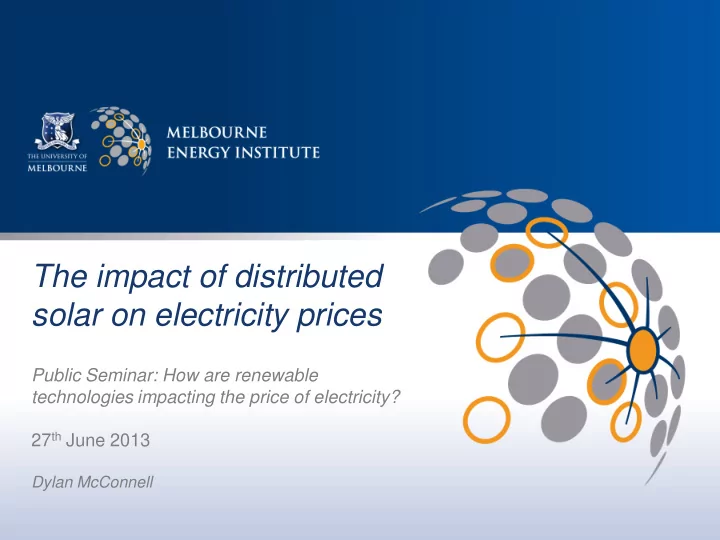

The impact of distributed solar on electricity prices Public Seminar: How are renewable technologies impacting the price of electricity? 27 th June 2013 Dylan McConnell
Solar in Australia [Source: CEC 2013]
Economic dispatch - how electricity markets work • Generators bid (offer) capacity into a wholesale market, for all the trading intervals • Generators offers are effected by a range of factors • Generators typically offer quantity in and around the marginal cost of production • The centralized market operator dispatches electricity from lowest [Source: Pöyry 2010] to highest price offer (i.e. in merit order), until enough electricity is dispatched to meet demand.
The principle of the merit order effect • Introduction of new low marginal cost generation capacity shifts the supply curve • The same dispatch target (demand) will result in a lower spot price [Source: Agora Energiewende2013] Increasing supply in a market puts downwards pressure on price
International experience: Germany The Merit Order Effect is a significant phenomena in Germany [Source: http://transparency.eex.com/]
International experience: Germany • Observed merit order effect: EEX 2008 [Source: http://transparency.eex.com/]
International experience: Germany • Observed merit order effect: EEX 2012 [Source: http://transparency.eex.com/]
Modelling the Merit Order Effect • Retrospective approach • Modelled historic solar generation, based on satellite data • Modified the historic demand, according to the solar generation • Used the modified demand to re-simulate electricity prices, using the historic generator offer data • Assumed bidding behavior was unchanged • Initially did this with a simplified model, for up to 5GW of solar
Results: Summer 2010 • Solar generation depresses electricity prices, particularly in summer peaks.
Modelling the Merit Order Effect • Improved solar model: Modelling a diverse range of locations and system orientations Different distributions of solar Improved market model 5 region market model Incorporates some of the constraints that effect the real market • Modelled scenarios up to 10GW
Results
Results
Results
Results
Results
Results
Results Hydro Brown Coal Black Coal Gas 0 (GWh/annum compared with 2 GW -2000 Change in Output 4 GW -4000 Baseline 6 GW 8 GW -6000 10 GW -8000 -10000 Hydro Brown Coal Black Coal Gas 0.00% 2 GW Change in Output (%) -2.00% 4 GW -4.00% 6 GW 8 GW -6.00% 10 GW -8.00% -10.00%
Results
Results
Results 2009 2010 2011 Market turnover 9.6 7.4 6 Value $1,073.00 $520.00 - Prev. analysis Percent 11.18% 7.03% - Cur. analysis Value $1,025.98 $497.19 $363.37 Percent 10.69% 6.72% 6.06%
Implications • Relationship between the spot market and retail price is not straight forward Bilateral contracts and vertical integration impact the flow through to the retail price • Degree of competition also effects the pass through Oligopolistic behavior may erode full pass through • There are legitimate costs associated with hedging and risk management that may increase as a result of increase solar
Longer term implications • Diminishing merit effect over time There is limit to how much the wholesale prices can reduce. • Supply/demand balance may re-correct, and the capacity overhang reduce: For example, a large generator may mothball However, given that approximately another 8GW of wind and 1-5 GW of solar are expected to be installed by 2020, and current demand trends, it may be some time before it does fully rebalance. • What happen to the market in the longer term, with high penetrations of renewables?
Summary • Distributed solar has a moderating effect on wholesale prices • These wholesale reductions may be passed through, at least in part • The reduction may go along way to off-setting the cost of support schemes Perhaps even more than off set? • A wealth transfer occurs from existing generators, to solar system owners.
Recommend
More recommend